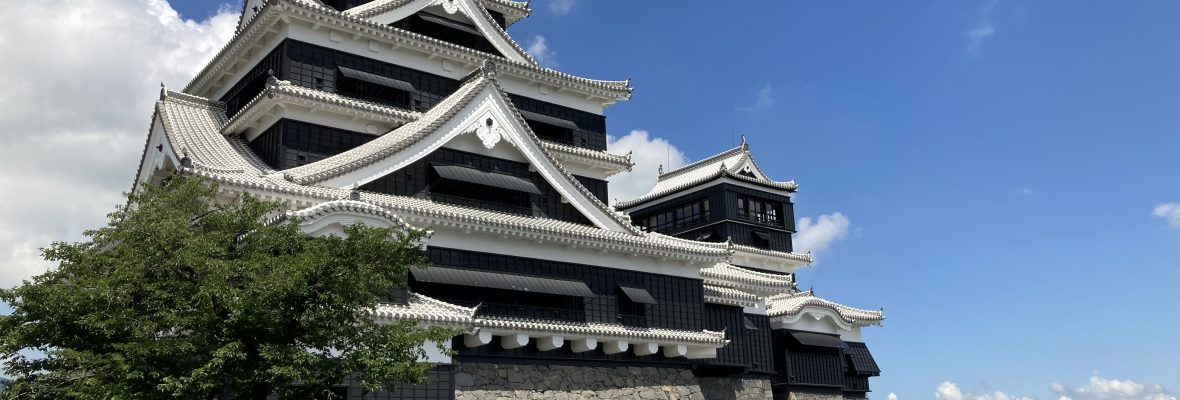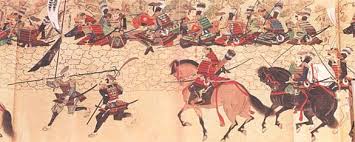Did a kamikaze really rescue Japan in 1274?
Apologies for jumping around a bit and interrupting the Ryuzoji Series. The whole family and I got Influenza A last week and put us all out of action for a week. I wasn’t able to continue writing the series but I have had this research bit sitting on my HD for a couple of months.
It is always exciting to stumble on new info, especially if it busts a myth or an established theory. As you know, I love studying this part of Japanese history so I hope you enjoy it and it makes you think to search for alternative histories.
Part 1.
During my research on the Matsuura Party and pirates of northern Kyushu I found a wonderful little book hiding away in the Fukuoka city library. The local libraries here in Fukuoka, Saga and Nagasaki are a treasure trove of information, much of which hasn’t been seen by English speakers. In one book I recently came across has some interesting information about the Mongol invasions that I hadn’t read before. For the most part, historians and especially the pop history writers have attributed the Mongolian defeat in the battle of 文永(ぶんえい)to a typhoon, but there is a theory among a few historians that disputes this account and questions the reliability of the typhoon story.
The basis for the theory of the kamikaze, otherwise known as a divine wind, is a historical record called “勘仲記(かんちゅうき – Kanchuki)”, which was written by 治部少輔勘解由小路兼仲 – Jibu Shosuke Kadenouji Kanenaka ), a 5th ranked official in Kyoto. He heard about the conflict in Hakata, Kyushu, and documented it in his records. He writes,
“Some say that tens of thousands of the enemy’s ships were floating on the sea, and suddenly a headwind blew and pushed them back to their own country. Some ships were even driven back to land. Therefore, 大鞆式部大夫 – Otomo Yoriyasu and others could capture more than fifty of the enemy. The headwind must be a blessing from the gods and was an auspicious occurrence. Lots of people are praying to the divine and donating money to shrines these days.”
On a clear day it is easy to see the Korean coastline from Tsushima. Lookouts were manned on the northern tip of Tsushima. After years of preparations, the Korean invasion fleet was spotted approaching from a dreadfully undermanned island. No doubt the Kamakura bakufu were aware of a possible combined Mongol attack on Japanese soil. There had been a number of envoys sent from Kubilai to Kamakura, to which most were met with the Koreans losing their heads, and a staunch refusal by the Japanese to give in to the Mongol demands. Such actions surely would have given thought to strengthening the defensive position of Tsushima, Iki and even Dazaifu which was the administration centre for the west of Japan, but no. Spotters saw the huge fleet starting to make sail and message was sent to Hakata/Dazaifu and also one directly to Kyoto by boat.
The Dazaifu administration known as Jito, under Shoni Kagesuke acted quickly once the message from Tsushima was received. It took the Mongols approximately two weeks to land on the Kyushu coast, first attacking Tsushima, then Iki. Although nothing could have been done to help the people of Tsushima and Iki, it did give local authorities time to message surrounding clans for help. Shoni samurai in Hakata were joined by the Kikuchi, Otomo, Harada, Kodama and the Matsuura. The invasion of northern Kyushu began to the west of Hakata on Matsuura lands in the early morning of December 15. The Mongols made their way to on land and by sea to Hakata and fighting began around the 19th. The Mongol invasion force retreated in the night on the 20th. The fight for Hakata and Dazaifu was a short and ferocious battle which lasted about 24 hours, the Matsuura samurai and local farmers were fighting for the whole 5 days and suffered the greatest losses. In his book, Shigeyoshi Yobuko writes, ‘it is a shame that the military exploits of the Matsuura are so overlooked due to the rarity of original documents’.
The second message from Tsushima arrived in Kyoto on November 17th. This message was forwarded to Kamakura and arrived on November 29th. Then, on December 3rd it was decided to send some Hojo samurai to Kyoto to defend the city. In the meantime, aristocrats in Kyoto and Kamakura were busy praying at local shrines and temples for a divine intervention to the invasion. No doubt they were thinking of the hundreds of Kyushu samurai fighting for their homelands and lives.
Back to Kanenaka in Kyoto. In his report, he conveyed that the headwind that sent the enemy fleet back to their own country was a blessing from the gods, and that the prayers for the retreat of the foreign enemies had brought about this victory. No mention in any court documents about the hundreds of local Kyushu samurai and peasants who did all the fighting and died in defense of their homelands.
So, is it reasonable to assume that the imperial court and aristocrats in Kyoto were completely powerless against the foreign invasion. Fighting was left up to local daimyo. The prayers and generous donations to the gods had been answered and a great kamikaze came and destroyed the invading force. Well, that is what the ruling elite would like you to believe.
The 八幡愚童記 “Hachiman Gudoki,” which documented the local situation of the battle, did not mention anything about a great wind. It only stated, “Rain fell heavily, and tears mixed with it. My sleeves were wet and soaked in blood. – The night seemed endless until the next morning. The next day, when I looked at Matsubara, there were no enemy troops camped there. I looked out to the sea, and there were no enemy ships that had been there until the previous evening.”
…They just wondered why the enemy ships had left.
In 元史日本伝(げんしにほんでん), The Annals of China in the Yuan Dynasty, describes the events as follows: In October of the eleventh year of the Zhiyuan era, we entered the country and were defeated. The army was not organized, all arrows were used, some soldiers were taken prisoner, so we returned home.
(NOTE: 元史日本伝 was written in China at that time)
The 東国通鑑(とうごくつうかん), Chronicle of the Eastern Region states that: We were a small but strong troop and succeeded in capturing a large enemy. The strategy of fighting the large enemy with emaciated soldiers was not feasible, so we decided to retreat to our boats and return to our base. However, that night we encountered a strong wind and rain and suffered many defeats as our boats collided with the cliffs.
(NOTE: 東国通鑑 was written in Korea at that time)
The above accounts suggest that the battle did not go according to plan. Due to exhaustion and a lack of arrows, the troops decided to retreat as they foresaw that continuing the fight would not be advantageous. Some of them even encountered a strong wind and rain during the retreat, causing them to lose visibility and collide with rocks, resulting in a significant defeat. The large-scale invasion of Japan did not achieve any remarkable results, and it was necessary to provide some sort of justification for the loss of many soldiers upon their return home. Therefore, it is likely that they used the damage caused by the wind and rain as one of the reasons for their defeat.
Part 2
Some other information I have found online also questions the kamikaze theory. On the morning after the Yuan and Goryeo (Korea) armies landed and advanced down to Dazaifu with a superior force, an “unbelievable event” occurred. Hakata Bay that was filled with enemy ships the day before was now calm and empty. One theory suggests that a great storm came, sinking many ships and killing many enemy soldiers. This wind was called “kamikaze,” or wind caused by the gods, and it is said to have given rise to the belief that the gods would protect Japan if enemies attacked the country. Other theories suggest that temples and shrines also had their own agenda for inventing a kamikaze theory as stated above by Kanenaka in Kyoto. However, there is now a growing belief that no storm occurred during the 文永の役(ぶんえいのえき).
As more information becomes available some have also doubted the true reason for the invasion. Some say that Kubilai did not intend to invade Japan in earnest and deployed his army to scare off the Japanese from the beginning. It seems likely that he intended to return after a short period of scaring the Japanese and during the first invasion he wanted to test the power and resources of the defending samurai, which, as we know became a reality in 1281. Additionally, the invasion dates in Japanese records and the Korean “History of Goryeo” do not exactly match, making it harder to confirm whether a typhoon occurred at the time or not. The Yahata Gudokun does not mention a storm, and it only states that there were no enemy ships or soldiers in sight in the morning.
Records show that Mongol ships had left Hakata Bay, so what happened to the retreating fleet? We can establish that the ships did not sink in a storm in Hakata Bay but in the Genkai Sea during winter when the waves are rough, and the weather is usually bad. The Genkai Sea often has strong northerly winds, each year trading ships often had to wait for a month or so, for the southern winds to blow again in order to return to Joseon Korea. It is recorded by the Yuan army that Japanese samurai were unexpectedly strong, and that a military council was held, saying, “If the battle is prolonged, we will run out of supplies and be defeated, so let’s go back.” The southerly wind probably blew at that time, and as the Japanese records show, the enemy suddenly disappeared.
However, this southerly wind did not last long and according to weather reports it only lasted half a day. By the time the Yuan and Goryeo army made their way back to Hakata Bay and loaded everything up onto the ships they didn’t leave Hakata until the middle of the night. Once the fleet reached Iki Island they were caught in a rainstorm which came from the north and most of the ships sank. The fleet was scattered and wreckage from the sunken ships drifted to the coasts of Tsushima, Iki, and back to Hakata. The largest number of wrecks was found near Iki, indicating that the wrecks must have been caught in a storm probably between Tsushima and Iki.
NOTE: There are many documents and evidence that a kamikaze came during the 弘安の役(こうあんのえき – Koan), this is not being disputed. The above text is discussing the first Mongol invasion, the 文永の役(ぶんえいのえき – Bunei).
Thankyou to Hiroko san for helping me with this translation.
Book references (Japanese)
松浦党研究連合会. 編集. 松浦党研究 芸文堂No.1 1980. (Editor, Matsuratou Kenkyu Rengoukai. Matsuura Clan Research No.1. Geibundo. 1980).
呼子重義. 海賊松浦党, 人物往来社 1965. (Shigeyoshi Yobuko. Matsuura Pirates, Jinbutsu Ouraisha. 1965)
田中 健夫, 倭寇―海の歴史, 講談社学術文庫. (Takeo Tanaka, Japanese Pirates – A history of the sea, Kodansha. 2012.
Other resources mentioned.
八幡愚童記 “Hachiman Gudoki
勘仲記(かんちゅうき) – Kanchuki
(English)
Conlan. Thomas. In Little Need of Divine Intervention: Takezaki Suenaga’s Scrolls of the Mongol Invasions of Japan. Cornell East Asia Series, 113
Turnbull, Stephen. 2010. The Mongol Invasions of Japan 1274 and 1281, Osprey
Wakabayashi, Haruko. Japanese Journal of Religious Studies 31, no. 1 (2004): 209–13. http://www.jstor.org/stable/30233748.
Zöllner, Reinhard. Monumenta Nipponica 58, no. 4 (2003): 531–33. http://www.jstor.org/stable/25066255.
Online (Japanese)
http://www.tamagawa.ac.jp/SISETU/kyouken/kamakura/genkou/index.html#bunei
Stuart Iles


You must be logged in to post a comment.